Amines - Properties and Reactivity of Amines (A-Level Chemistry)
Properties and Reactivity of Amines
Amines as Bases
A base is a substance which can act as a proton acceptor.
Ammonia, primary aliphatic and primary aromatic amines all possess a lone pair of electrons on the N atom, which can accept protons.
They all undergo reversible reactions in water and are therefore weak bases in water.
Ammonia, Primary Amines, Aromatic Amines in Water
The reactions for each substance in water is:
• Ammonia + water ⇌ ammonium ion + hydroxide ion.
![]()
• Ethylamine + water ⇌ ethylammonium ion + hydroxide ion
![]()
• Phenylamine + water ⇌ phenylammonium ion + hydroxide ion
![]()
The formation of hydroxide ions produces alkaline solutions.
The equilibrium for all the reactions, lies far to the left, making them all weak bases.
There are, however, differences in the relative strengths of ammonia, primary aliphatic and primary aromatic amines as bases.
Relative Base Strength
The strength of the base, depends on the ability of the lone pair of electrons on the nitrogen atom to accept protons.
The more available, or higher the electron density on the lone pair of electrons, the stronger the base.
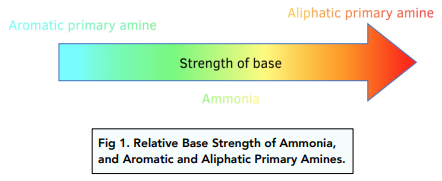
Explanation of Relative Base Strength
In a primary aromatic amine, the lone pair of electrons on the N attached to the ring, become delocalised with the electrons within the benzene ring.
The lone pair on the N are less available to accept a proton, and therefore are weaker bases.
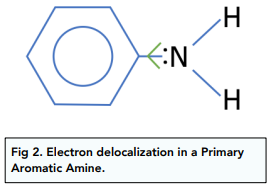
In a primary aliphatic amine, the alkyl group attached to the N has a positive inductive effect, which increases the electron density on the N atom.
The lone pairs of electrons are more readily available and the strength of the base is increased.
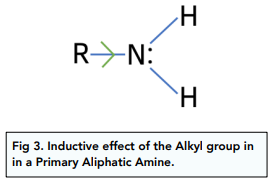
Worked Example: Compare the two structures below, and explain which is the strongest base. (6 marks)
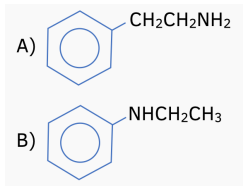
Answer:
A is a stronger base compared to B (1)
The N is attached directly to the benzene ring in B. Therefore the lone pair of electrons on the nitrogen atom (1) are delocalised with the electrons (1) in the benzene ring and are less available. (1)
In A, the ethyl group has a positive inductive effect (1). The lone pair of electrons on the N are more readily available (1), as the electron density is higher, and it is therefore a stronger base.
Reactions with Acids
Amines – both aliphatic and aromatic – will react with acids in a neutralisation reaction to form ammonium salts.
Complex Ion Formation with Copper(II) Ions
A solution of copper (II) sulfate contains [Cu(H₂O)₆]²⁺ complex ions. Upon adding butylamine, a pale blue precipitate of copper hydroxide [Cu(OH)₂(H₂O)₄] forms. This is because the butylamine acts as a base and removes a proton from two of the water molecules in the complex.
If excess butylamine is added, the precipitate redissolves and the solution turns deep blue as a ligand substitution reaction takes place. Some of the water molecules are replaced by butylamine molecules to form [Cu(CH₃(CH₂)₃NH₂)₄(H₂O)₂]²⁺ complex ions.
Amines as Nucleophiles
Nucleophilic Substitution Reactions with Halogenoalkanes
All amines have a lone pair of electrons on the N atom. Therefore, they can all act as nucleophiles in nucleophilic substitution reactions with halogenoalkanes.
In the reaction described earlier to make ethylamine from bromoethane and ammonia, the ethylamine produced can also act as a nucleophile and will attack another bromoethane.
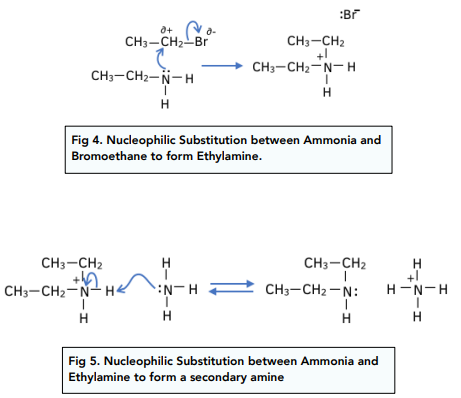
This is known as further substitution, and a secondary amine is formed.
The secondary amine produced, can also act as a nucleophile, attacking another halogenoalkane molecule, to produce a tertiary amine.
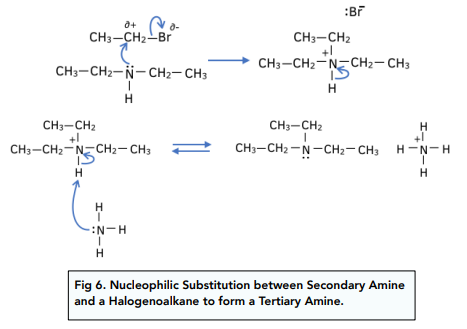
The tertiary amine can also act as a nucleophile, attacking another halogenoalkane molecule to produce a quaternary ammonium salt.
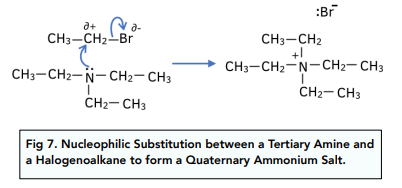
This quaternary ammonium salt is called tetraethylammonium bromide (CH₃CH₂)₄N⁺Br-. The salt is ionic and will therefore dissolve in water.
The quaternary ammonium salt has no lone pair of electrons and therefore no further substitution can occur.
Quaternary Ammonium Salts
The general structure of a quaternary ammonium salt is:
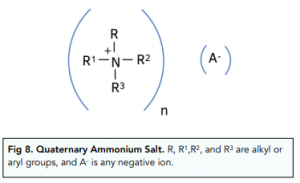
Some quaternary ammonium salts contain at least one long hydrocarbon chain, as shown below. This molecule has:
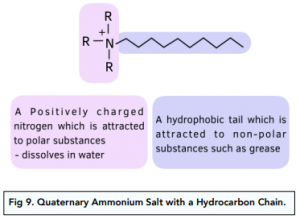
These type of quaternary ammonium salts are used a cationic surfactants in fabric conditioners and hair softeners.
The positive cationic head is attracted to negatively charged fibres or protein sites on hair molecules, which reduces static charge and has a conditioning effect on clothes and hair, making them softer.
Nucleophilic Addition-Elimination Reactions
The lone pair of electrons on the N atom in ammonia and primary amines, enables them to act as nucleophiles.
In acyl chlorides and acid anhydrides, there is polarisation between the C and the O atom. The C is slightly positively charged and open to nucleophilic attack from the lone pair on the N atoms.
The reactions between ammonia and primary amines with acyl chlorides and acid anhydrides are nucleophilic addition-elimination reactions.
Worked Example: Name and outline a mechanism for the reaction between propanoyl chloride and ethylamine. Name the product formed. (6)
Answer: Nucleophilic addition-elimination reaction. The product formed is called N-ethylpropanamide (1)






Still got a question? Leave a comment
Leave a comment